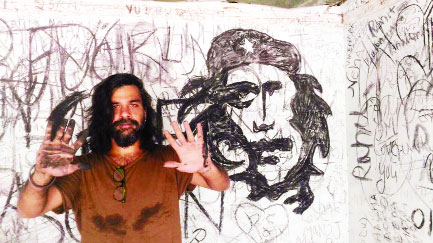Asmita Sarkar says that Kabir Singh Chaudhary, a film director, perfectly shows how emotionless the camera can be.
When a filmmaker starts comparing his own craft to that of an assassin while making a film about someone who was assassinated, the lines blur between him as an outsider looking in and the audience.
Kabir Singh Chowdhry’s road movie about Amar Singh Chamkila’s life, Mehsampur, belongs in no man’s land but for the ease of slotting them at festivals, he chose to call it a mockumentary.
More than Chamkila’s life, it centres around the lives of the individuals who survived the assassination on March 8 1988. The filmmaker’s road trip across Punjab while researching brought him to individuals who had been subject to police torture during the Khalistan movement.
“During my own research, I met mothers who don’t have closure since their children were killed in a false encounter. They haven’t seen their children’s bodies and are still waiting even to see a photo of their dead body. After a point, I didn’t have the emotional bandwidth and it felt like a comedy after the 30th person showed me how his thighs were stretched out. I was sensitive for a few but they just kept coming one after the other and it felt routine,” he said.
While researching for a fictional film I was planning around Chamkila I met these individuals and wondered what would happen if instead of me listening to their story, a filmmaker with a camera and a limited amount of time rushes through these stories and thus the idea for his shoestring budget Mehsampur, a metafiction film came about. He deliberately chose the people connected with Chamkila’s life or those who witnessed his assassination to pay themselves.
The sensitive director has analysed the evils of the process in which a filmmaker uses individuals for selfish purposes. He said that a camera is now like a gun, in which you are told to point, aim and shoot and the clothing is like battle fatigue, with a million pockets to fit things in. “It’s more about how intrusive filmmakers can be with their cameras. They dig into other people’s trauma for their selfish motives,” he said.
The subject matter too is something that can be considered anything but ordinary. Chamkila had been controversial and revolutionary. He wrote and sang of extra-marital relationships, coming of age, drinking, drug use and the hot tempers of Punjabi men but what came through most was the critical view of the society.
Mehsampur is the place where he and his wife Amarjot had been gunned down while stepping on to the stage. “There is a certain obsession among the characters as well as the diaspora, with that place. The script moves from Chandigarh to Ludhiana to Mehsampur.
“There’s a certain obsession with Chamkila in the Punjabi diaspora in Canada, UK and US. I grew up in Punjab and was familiar with the music and five years ago I started thinking about how this artist was fearless and continued to sing despite threats. He would perform at Akhadas (arenas), which were the haunts of separatists who were trigger happy, and yet he persisted despite the pressures and was famous too,” he said.
The film is unlikely to give a closure to the mothers or the audience because it doesn’t solve the mystery of Chamkila’s death instead it follows the protagonist, an evil version of Kabir, the filmmaker, who has written the first draft of the script and he’s stepped out to just collect data about that era and people who were connected to Chamkila.
The characters play a version of themselves or what the writers think are a version. One of the main characters is a man called Lal Chand, who was there during the assassination. He was the dholak player and survived with a bullet wound. “The female characters are also playing themselves but interpreted by us. We could be wrong in saying that they’re playing versions,” he said. To make them act, there was a treatment note but most of it was a waiting game until these non-actors could hit those emotional marks.
The film, he believes, is a reflection on the human condition and holds up a mirror to show how unemotional most people are and how cold the camera can be. From the filmmaker’s obsession to the individuals who have been reciting their trauma by rote, it seems all of them have been left drained of emotions.
Writer: Asmita Sarkar
Courtesy: The Pioneer








 OpinionExpress.In
OpinionExpress.In















Comments (0)